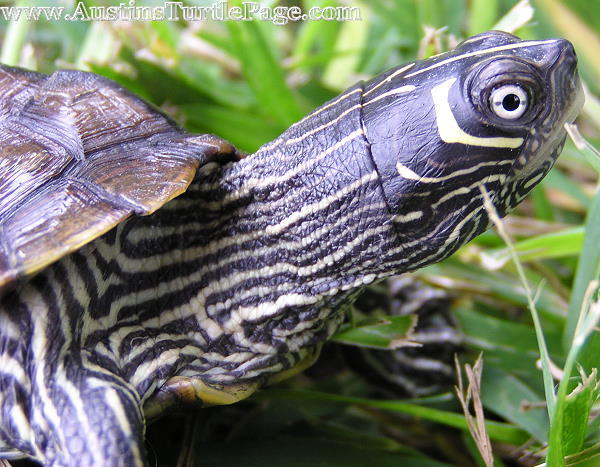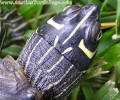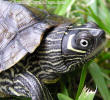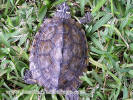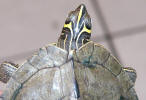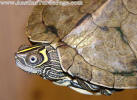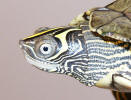|
|
|
|
|
Carapace - One of distinguishing features of map turtles is the ridge of black tipped knobs running along the spine, and the jagged rear carapace edge. The shell is typically olive to brown with an intricate pattern of yellow to orange semi-circles on the carapace scutes (reminiscent of a road map); these patterns often fade with age & may be obscured by algae overgrowth. Mississippi maps have moderately prominent black-tipped knobbing (less than Black-Knobbed maps, more than Common maps). Plastron - The plastron is tan to yellowish with brown lines resembling wood grain at the edges of the scutes. These fade with age and become less distinct. The plastron may have some dark patterning. Head - The head of the Mississippi map has the main identifying feature. On the side of the head there will be a curved line (a ‘reverse crescent’) that curves down behind & sweeps under the eye. From the top view there is a single line running down the center of the head separating the two crescent lines on the sides. Another semi-reliable distinguishing feature is the round pupil & bright, unbroken iris; Mississippi maps stereotypically have no bar across the pupil (unlike Ouachita & False maps), though exceptions exist. Size - Females are considerably larger than males. The male being 3 ½” to 5” and the female anywhere from 6” to 10” SCL. Males have a leaner look more like juveniles, but females have a bulkier build. Map turtles get their name from the lines and markings on their carapace which resemble the contour lines of a map. Sex can be determined by examining the tail. The tail of the female is considerably smaller than that of the male. The male has a much thicker-based and longer tail than the small petite tail of the female. Males also have slightly longer nails on the forelegs (similar to painted males, but not the extent of male sliders & cooters). |
||
|
|
|
|
|
|
|
|
They occur in the Mississippi Valley from
Illinois and Nebraska, down into the Gulf States from Mississippi to Texas,
usually in rivers, lakes and large streams (not typically in isolated farm ponds
or small creeks). They tend to prefer habitat with abundant vegetation.
|
||
|
|
|
|
|
|
|
||||
TEMPERATURE RANGE (°F)
Male Mississippi Maps are decent beginner turtles. They may be among the more skittish turtles to keep (individuals vary; map turtles as a class have a reputation for being skittish) but overall care is the same as sliders & painted turtles (albeit high water quality may be even more important with some map species). Females do get larger, up to 10", and can be a strain on housing, so consider an intermediate turtle CAPTIVE DIET Mississippi Map turtles are omnivores (but as adults more carnivorous than sliders). They’re easily over-fed protein resulting in an unhealthy growth rate and pyramiding of the shell. They readily eat live foods such as crickets, earth worms, and meal worms, & commercial dry foods such as Mazuri and ReptoMin. They will also eat some vegetables such as Romaine lettuce. RECOMMENDED FEEDING SCHEDULE Hatchlings require once daily feeding up to about 6 months. At this age, a diet of pellets and live foods is recommended. Feed just enough to keep them from being hungry, but don’t let them gorge themselves. After 6 months or so cut back on the feedings to every other day and add vegetation into the diet. Adjust amount of food at feeds accordingly with growth rate. Romaine lettuce may be offered ‘all you can eat’ at any age (romaine is mostly water, & not apt to overload them on protein). CAPTIVE HABITAT They are avid swimmers and baskers. They need a good basking area where they can get totally out of the water and get completely dry (including the plastron; the basking platform must dry out, not remain wet/damp). This area will not only need a heat source, but ideally should have a source of UVB (UV-B lighting is strongly recommended if you aren’t confident dietary Vitamin D3 is sufficient, particularly for growing hatchings). This is accomplished with lighting (usually either a UV-B fluorescent such as a ReptiSun 5.0 for UV-B & a separate basking lamp for heat; some UV-B mercury vapor bulbs are an option). Being avid swimmers they need plenty of swimming room, both vertical and horizontal. Map turtles as a class have a reputation for being more prone to health problems if high water quality isn’t maintained; it’s unclear how much of an issue this is for Mississippi maps. RECOMMENDED ENCLOSURE A single adult male would do fine in a 75-90 gallon enclosure, but a 10 inch female will need at least a 125 gallon enclosure to insure adequate space. A basking area can be made of driftwood, smooth or flat rocks, or anything else non abrasive, non toxic, and capable of supporting the weight of the turtle. The basking area should be large enough for the turtle to get the entire body out of the water and dry. Strong filtration is recommended to maintain high water quality. A submersible heater to ensure water temp.s don’t drop far is recommended, preferably with a heater guard to reduce burn risk. Substrate isn’t critical but a complex landscape to explore could include river rock (but take care the turtle isn’t apt to strike hard objects diving off the basking platform). To add additional Mississippi (or similar-sized) maps to a habitat we recommend you increase the size of the tank accordingly by half (i.e.; 1 male = 75 gallons, 2 males = 110 gallons, etc). Stock tanks also make great alternatives to glass and acrylic aquariums. If your map is one of the skittish ones, consider placing the enclosure to a less traveled area (i.e.: spare bedroom) to reduce stress. WATER DEPTH Map turtles are excellent swimmers and will do better in deeper waters. Even as hatchlings they prefer (relatively) deeper setups, albeit with plenty of cover for security. COMMUNITY HABITAT Mississippi map turtles are usually good community turtles. Being of a more timid nature they seldom show aggression. As with other turtle species, aggression may occur among males competing over a female to mate, & sexual harassment of females by males by become troublesome enough to warrant separation. |
||||||
|
|
|
|
|
|
|
| Egg clutches can be up to 22 eggs & take between 52 and 85 days to hatch (depending on temperature). Males are generally produced at 77° - 83° F, Females at 88° - 95° F, and mixed genders at 83° - 88° F. | ||
|
|
|
|
|
|
|
|
ENCLOSURE Even as hatchlings they are adept at swimming in deeper water and a hatchlings habitat has proportionately the same requirements as that of an adult. For very small hatchlings (around 50 cent piece-sized) open with around 8 inch water depth & increase over a few weeks.) Use the same type of lighting (UV-B & also heat.) We recommend additional plants (live or artificial) and other items protruding from the water surface. This gives the young hatchling additional hiding places as well as more places to rest; wild hatchling turtles are vulnerable & secretive, so plenty of cover is preferable to an ‘open water’ habitat. Due to the sensitivity of hatchlings, and a fairly high mortality rate, water temps should be kept warmer than adults, between 78° and 80°F. DIET They do well on a diet of ‘whole-prey’ foods like worms, fish & crickets augmented by a quality commercial turtle food such as Mazuri or ReptoMin. Veggies should be offered, although some hatchlings do not take to them until they are older. Youngsters may or may not take to commercial foods. If they do not take in food known to contain Vitamin D3 (typically commercial foods), be sure to provide UV-B lighting. Bloodworms are fine for coaxing reluctant feeders but nutritionally insufficient for a staple. Finely shopped small earthworm bits, freshly killed & crushed guppies & small feeder crickets & grasshoppers are fine choices. Hatchlings are shy & fragile so don’t try feeding outside the tank until at least several weeks of well-being feeding in the tank (if you do this at all). |
||
|
|
|
